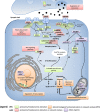System-based proteomic and metabonomic analysis of the Df(16)A+/- mouse identifies potential miR-185 targets and molecular pathway alterations
- PMID: 27001617
- PMCID: PMC5322275
- DOI: 10.1038/mp.2016.27
System-based proteomic and metabonomic analysis of the Df(16)A+/- mouse identifies potential miR-185 targets and molecular pathway alterations
Abstract
Deletions on chromosome 22q11.2 are a strong genetic risk factor for development of schizophrenia and cognitive dysfunction. We employed shotgun liquid chromatography-mass spectrometry (LC-MS) proteomic and metabonomic profiling approaches on prefrontal cortex (PFC) and hippocampal (HPC) tissue from Df(16)A+/- mice, a model of the 22q11.2 deletion syndrome. Proteomic results were compared with previous transcriptomic profiling studies of the same brain regions. The aim was to investigate how the combined effect of the 22q11.2 deletion and the corresponding miRNA dysregulation affects the cell biology at the systems level. The proteomic brain profiling analysis revealed PFC and HPC changes in various molecular pathways associated with chromatin remodelling and RNA transcription, indicative of an epigenetic component of the 22q11.2DS. Further, alterations in glycolysis/gluconeogenesis, mitochondrial function and lipid biosynthesis were identified. Metabonomic profiling substantiated the proteomic findings by identifying changes in 22q11.2 deletion syndrome (22q11.2DS)-related pathways, such as changes in ceramide phosphoethanolamines, sphingomyelin, carnitines, tyrosine derivates and panthothenic acid. The proteomic findings were confirmed using selected reaction monitoring mass spectrometry, validating decreased levels of several proteins encoded on 22q11.2, increased levels of the computationally predicted putative miR-185 targets UDP-N-acetylglucosamine-peptide N-acetylglucosaminyltransferase 110 kDa subunit (OGT1) and kinesin heavy chain isoform 5A and alterations in the non-miR-185 targets serine/threonine-protein phosphatase 2B catalytic subunit gamma isoform, neurofilament light chain and vesicular glutamate transporter 1. Furthermore, alterations in the proteins associated with mammalian target of rapamycin signalling were detected in the PFC and with glutamatergic signalling in the hippocampus. Based on the proteomic and metabonomic findings, we were able to develop a schematic model summarizing the most prominent molecular network findings in the Df(16)A+/- mouse. Interestingly, the implicated pathways can be linked to one of the most consistent and strongest proteomic candidates, (OGT1), which is a predicted miR-185 target. Our results provide novel insights into system-biological mechanisms associated with the 22q11DS, which may be linked to cognitive dysfunction and an increased risk to develop schizophrenia. Further investigation of these pathways could help to identify novel drug targets for the treatment of schizophrenia.
Conflict of interest statement
SB is a director of Psynova Neurotech. The remaining authors declare no conflict of interest.
Figures



Similar articles
-
Hippocampal Proteomic and Metabonomic Abnormalities in Neurotransmission, Oxidative Stress, and Apoptotic Pathways in a Chronic Phencyclidine Rat Model.J Proteome Res. 2015 Aug 7;14(8):3174-87. doi: 10.1021/acs.jproteome.5b00105. Epub 2015 Jun 30. J Proteome Res. 2015. PMID: 26043028
-
Untargeted metabolomic, and proteomic analysis identifies metabolic biomarkers and pathway alterations in individuals with 22q11.2 deletion syndrome.Metabolomics. 2024 Feb 28;20(2):31. doi: 10.1007/s11306-024-02088-0. Metabolomics. 2024. PMID: 38418685 Free PMC article.
-
An antisense oligonucleotide-based strategy to ameliorate cognitive dysfunction in the 22q11.2 Deletion Syndrome.Elife. 2025 May 27;13:RP103328. doi: 10.7554/eLife.103328. Elife. 2025. PMID: 40420562 Free PMC article.
-
Update on the 22q11.2 deletion syndrome and its relevance to schizophrenia.Curr Opin Psychiatry. 2017 May;30(3):191-196. doi: 10.1097/YCO.0000000000000324. Curr Opin Psychiatry. 2017. PMID: 28230630 Review.
-
MicroRNAs as the cause of schizophrenia in 22q11.2 deletion carriers, and possible implications for idiopathic disease: a mini-review.Front Mol Neurosci. 2013 Dec 5;6:47. doi: 10.3389/fnmol.2013.00047. Front Mol Neurosci. 2013. PMID: 24367288 Free PMC article. Review.
Cited by
-
Shank3 mutation in a mouse model of autism leads to changes in the S-nitroso-proteome and affects key proteins involved in vesicle release and synaptic function.Mol Psychiatry. 2020 Aug;25(8):1835-1848. doi: 10.1038/s41380-018-0113-6. Epub 2018 Jul 9. Mol Psychiatry. 2020. PMID: 29988084 Free PMC article.
-
A mouse model of 22q11.2 deletions: Molecular and behavioral signatures of Parkinson's disease and schizophrenia.Sci Adv. 2018 Aug 15;4(8):eaar6637. doi: 10.1126/sciadv.aar6637. eCollection 2018 Aug. Sci Adv. 2018. PMID: 30116778 Free PMC article.
-
Impaired OTUD7A-dependent Ankyrin regulation mediates neuronal dysfunction in mouse and human models of the 15q13.3 microdeletion syndrome.Mol Psychiatry. 2023 Apr;28(4):1747-1769. doi: 10.1038/s41380-022-01937-5. Epub 2023 Jan 6. Mol Psychiatry. 2023. PMID: 36604605 Free PMC article.
-
Intellectual disability: dendritic anomalies and emerging genetic perspectives.Acta Neuropathol. 2021 Feb;141(2):139-158. doi: 10.1007/s00401-020-02244-5. Epub 2020 Nov 23. Acta Neuropathol. 2021. PMID: 33226471 Free PMC article. Review.
-
Systems Analysis of the 22q11.2 Microdeletion Syndrome Converges on a Mitochondrial Interactome Necessary for Synapse Function and Behavior.J Neurosci. 2019 May 1;39(18):3561-3581. doi: 10.1523/JNEUROSCI.1983-18.2019. Epub 2019 Mar 4. J Neurosci. 2019. PMID: 30833507 Free PMC article.
References
Publication types
MeSH terms
Substances
Grants and funding
LinkOut - more resources
Full Text Sources
Other Literature Sources
Miscellaneous

